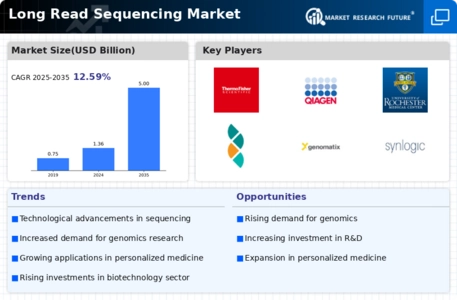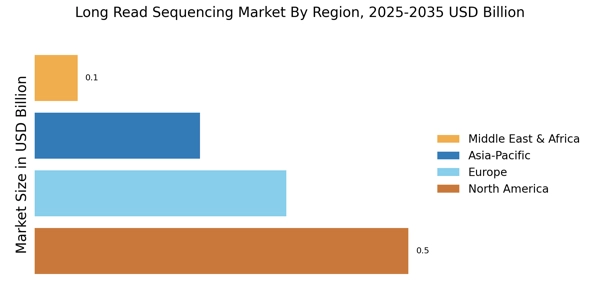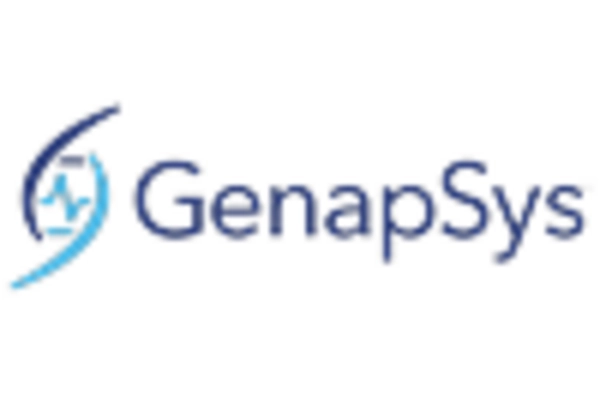Collaborative Research Initiatives
The Long Read Sequencing Market benefits from collaborative research initiatives that foster innovation and knowledge sharing. Academic institutions, research organizations, and biotechnology companies are increasingly partnering to explore the applications of long read sequencing in various fields, including oncology, microbiology, and evolutionary biology. These collaborations often lead to the development of new methodologies and technologies that enhance sequencing accuracy and efficiency. Furthermore, funding from governmental and non-governmental organizations supports these initiatives, driving the market forward. As a result, the Long Read Sequencing Market is likely to see a rise in research publications and clinical trials, which will further validate the utility of long read sequencing in diverse applications. This collaborative approach not only accelerates advancements but also broadens the scope of long read sequencing in scientific research.
Growing Investment in Genomic Research
The Long Read Sequencing Market is experiencing a notable increase in investment directed towards genomic research. Governments and private entities are recognizing the potential of genomics in addressing critical health challenges and are allocating substantial funds to support research initiatives. This influx of capital is facilitating the development of advanced sequencing technologies and infrastructure, thereby enhancing the capabilities of long read sequencing. Market analysts indicate that this trend is likely to continue, with investments projected to reach unprecedented levels in the next few years. Such financial backing not only accelerates technological advancements but also promotes the establishment of research centers dedicated to long read sequencing. Consequently, the Long Read Sequencing Market stands to benefit from a robust ecosystem that encourages innovation and application in various sectors, including healthcare and agriculture.
Increased Demand for Precision Medicine
The Long Read Sequencing Market is witnessing an increased demand for precision medicine, which necessitates advanced genomic analysis. As healthcare shifts towards personalized treatment plans, the ability to obtain detailed genomic information becomes paramount. Long read sequencing provides insights into complex genetic disorders and rare diseases, enabling tailored therapeutic strategies. The market is responding to this demand, with projections indicating a substantial increase in revenue, potentially reaching several billion dollars by the end of the decade. This trend is further supported by the growing awareness among healthcare providers and patients regarding the benefits of precision medicine, which emphasizes the importance of individualized treatment based on genetic profiles. Consequently, the Long Read Sequencing Market is positioned to play a critical role in the future of healthcare.
Technological Advancements in Sequencing
The Long Read Sequencing Market is experiencing a surge in technological advancements that enhance sequencing capabilities. Innovations such as nanopore sequencing and single-molecule real-time sequencing are revolutionizing the field. These technologies allow for longer reads, which are crucial for accurately assembling genomes and detecting structural variations. As a result, the market is projected to grow significantly, with estimates suggesting a compound annual growth rate of over 20% in the coming years. This growth is driven by the need for more comprehensive genomic data, which is essential for applications in personalized medicine and genetic research. The integration of artificial intelligence in data analysis further propels the efficiency and accuracy of long read sequencing, making it a pivotal component in the evolution of genomics.
Rising Applications in Agriculture and Environmental Science
The Long Read Sequencing Market is expanding its reach into agriculture and environmental science, driven by the need for sustainable practices and biodiversity conservation. Long read sequencing enables researchers to analyze complex genomes of crops and microorganisms, facilitating the development of genetically modified organisms that can withstand environmental stresses. This capability is increasingly important as the global population grows and food security becomes a pressing issue. Additionally, environmental scientists utilize long read sequencing to study microbial communities and their roles in ecosystems, which is vital for understanding ecological dynamics. The market is likely to see a rise in demand for long read sequencing technologies in these sectors, as stakeholders recognize their potential to address challenges related to climate change and resource management. This diversification of applications underscores the versatility and importance of the Long Read Sequencing Market.


















Leave a Comment